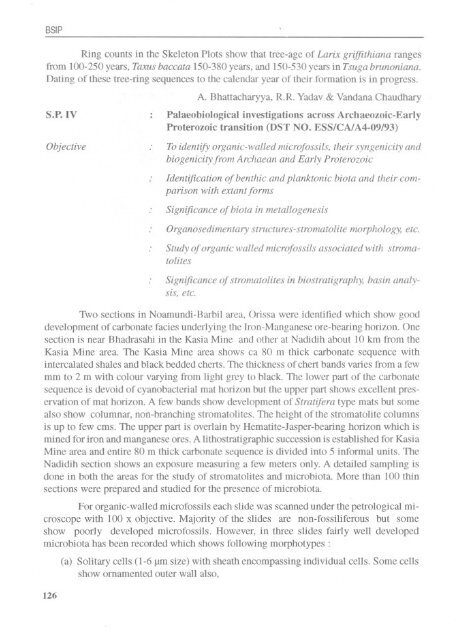1994-95 - Birbal Sahni Institute of Palaeobotany
1994-95 - Birbal Sahni Institute of Palaeobotany
1994-95 - Birbal Sahni Institute of Palaeobotany
Create successful ePaper yourself
Turn your PDF publications into a flip-book with our unique Google optimized e-Paper software.
BSIP<br />
Ring counts in the Skeleton Plots show that tree-age <strong>of</strong> Larix grijfithialla ranges<br />
from 100-250 years, Taxus baccata 150-380 years, and 150-530 years in Tsuga brwlOllialla.<br />
Dating <strong>of</strong> these tree-ring sequences to the calendar year <strong>of</strong> their formation is in progress.<br />
S.P.IV<br />
A. Bhattacharyya, R.R. Yadav & Vandana Chaudhary<br />
Palaeo biological investigations across Archaeozoic-Early<br />
Proterozoic transition (OST NO. ESS/CAlA4-09/93)<br />
Objective<br />
To identify orgallic-walled micr<strong>of</strong>ossils. their sy"ge"icity alld<br />
biogellicity from Archaean and Early Proterozoic<br />
Identification <strong>of</strong> benthic and planktollic biota alld their comparison<br />
with extant forms<br />
Significallce <strong>of</strong> biota ill metallogellesis<br />
Organosedimentary struC/ltres-stromatolite morphology. etc.<br />
associated with stroma<br />
Study <strong>of</strong> orgallic walled micr<strong>of</strong>ossils<br />
tolites<br />
Significance <strong>of</strong> stromatolites in biostratigraph)\ basin analysis.<br />
etc.<br />
Two sections in Noamundi-Barbil area, Orissa were identified which show good<br />
development <strong>of</strong> carbonate facies underlying the Iron-Manganese ore-bearing horizon. One<br />
section is near Bhadrasahi in the Kasia Mine and other at Nadidih about 10 km from the<br />
Kasia Mine area. The Kasia Mine area shows ca 80 m thick carbonate sequence with<br />
intercalated snales and black bedded cherts. Thc tnickness <strong>of</strong>cnClt bands varies from a few<br />
mm to 2 m with colour varying from light grey to black. The lower part <strong>of</strong> the carbonate<br />
sequence is devoid <strong>of</strong> cyanobacterial mat horizon but the upper part snows excellent preservation<br />
<strong>of</strong> mat horizon. A few bands show development <strong>of</strong> Strati/era type mats but some<br />
also snow columnar, non-branching stromatolites. The height <strong>of</strong> the stromatolite columns<br />
is up to few ems. The upper part is overlain by Hematite-Jasper-bearing horizon which is<br />
mined for iron and manganese ores. A lithostratigraphic succession is established for Kasia<br />
Mine area and entire 80 m thick carbonate sequence is divided into 5 informal units. The<br />
Nadidih section shows an exposure mea~uring a few meters only. A detailed sampling is<br />
done in both the areas for the study <strong>of</strong> stromatolites and microbiota. More than 100 thin<br />
sections were prepared and studied for lhe presence <strong>of</strong> rnicrobiota.<br />
For organic-walled micr<strong>of</strong>ossils each slide was scanned under the petrological microscope<br />
with lOa x objective. Majority <strong>of</strong> lhe slides are non-fossiliferous but some<br />
show poorly developed micr<strong>of</strong>ossils. However, in lhree slides fairly well developed<br />
microbiota has been recorded whicb shows following morphotypes :<br />
(a) Solitary cells (1-6lJ111 size) with sheath encompassing individual cells. Some cells<br />
show ornamented outer wall also,<br />
126

















